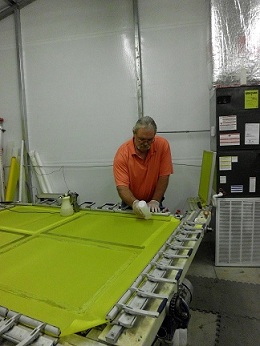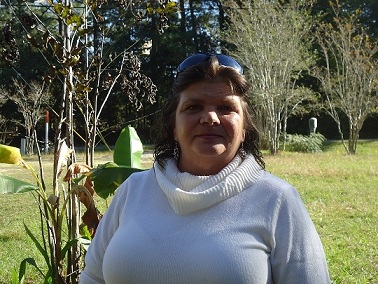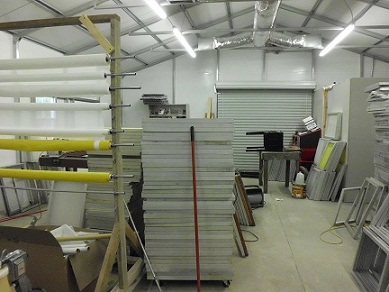Two days before Christmas in 2007, Glenn and Sara Sasser's planswere obliterated like an unsuspecting step on a hidden landmine.
|On a recent truck run from Columbus to Macon in Georgia, Glennspoke softly, pausing a few times when he remembered the day hiswife of 20 years passed away on Dec. 23 that year.
|“She died in my arms. It was unexpected. She had lung cancer. Atumor ruptured, and she bled to death.”
|The next two years were a haze, Sasser said. He kept on working,staying on the road, trying to keep the pain and loneliness at bay.But buried way down beneath the hurt was a path that his wife wouldwant him to continue on.
|“I walked out on the porch one cool, crisp Saturday morning,took a deep breath and said, 'It's time to get on with my life,'”Sasser recalled.
|Perhaps saying that thought out loud shifted the course of whatwas then a burgeoning silkscreen business.
|At the age of 55, Sasser's routines have become more of abarometer of what takes priority over time wasters. Adhering to atight schedule can mean the difference between getting paid formaking a haul on time versus filling an order to remesh 100 oldframes so that a wholesaler can have them back in time for thegrand opening of a new restaurant.
|Dressed in a tangerine colored shirt and blue jeans, at aroundsix feet tall and with a hulky build, Sasser acknowledged he cancome across as intimidating. His neck-length silver hair in a looseponytail and a deep, all-business voice cloaked in a southerntwang, he rarely cracked a smile. But when he did, his entire facelit up.
|Glenn Sasser, owner of A Plus Silk Screen, applies glues towide swaths of mesh that will adhere to the frames in seconds.Alabama Telco Credit Union helped provide the capital to purchaseone of several of the stretchers like the one picturedhere.
|Financial Setbacks
|He likely takes on a no-nonsense demeanor to keep the focus onbuilding A Plus Silk Screen, a small business in Odenville, Ala., aone traffic-light town of 3,585 about 20 miles northeast ofBirmingham. Sasser takes used frames, turns them into new ones andapplies a silk screen so that designs can be transferred oneverything from cereal boxes to bottles to ink pens.
|The procedure may sound straightforward, but there are a numberof moving parts behind the scenes to make it all happen. How Sassercame to start up his fledgling10-year old business is a series oftwists and turns peppered along the way with personal and financialsetbacks. The $590 million Alabama Telco Credit Union inBirmingham, Ala., filled the voids after several banks flatlyrefused to provide financing. Among them, BB&T and Bank ofAmerica.
|“We needed a cash injection. Small businesses can't afford toabsorb fees like the bigger ones can,” Sasser said. “We're notgoing anywhere” of his relationship with the credit union.
|There are many outfits offering silk screening, but only ahandful are engaged on a national scale in the manufacturing offrames, Sasser said. Given the contacts he had made over the years,he knew he could break in, but the knowledge didn't comeovernight.
|“It was a lot of trial and error. A lot. It was certainlylearning as you go.”
|In the middle of that learning curve was figuring out where andwho would provide the capital for a business so unique, possiblytoo risky and most likely unheard of by most lenders. At one point,Sasser had 13 different accounts at Telco. While most were on theconsumer side, he held a few business deposits at thecooperative.
|As the silk screen business grew, and Sasser ventured more intoremeshing and frame manufacturing, his quest for the right kind ofequipment took him around the country and beyond to China. Afterobtaining an import-export license in 2010, he was able toestablish a contact there that sold him mesh cheaply and that wasnot sold in the United States.
|But Telco, which is how many members refer to the credit union,didn't offer international wire transfers, a critical transactionfor shipping the mesh across international borders. After someconsideration, he moved his business accounts down the street to abranch belonging to the $178.5 billion BB&T Corp., which didhandle international remittances.
|“The one thing about dealing with companies abroad is thingshave to be paid up front,” Sasser said. “I have had CDs, moneymarket accounts, pretty much everything Telco had to offer. Mybusiness stayed with them until I had to go to BB&T.”
|It is a decision Sasser regrets to this day. He applied for a$25,000 loan to continue building the silkscreen business. Despitehaving $40,000 in savings at BB&T, a 789 credit score and asolid financial history, he was turned down. The bank said Sasserhad not been a BB&T customer long enough.
|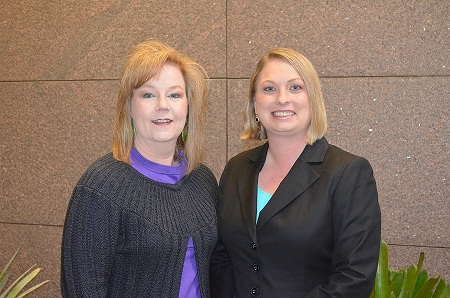
Lynn Middleton, branch manager (left) at Alabama Telco,who's known Glenn Sasser for at least a decade, said he has areputation for being an honest man. Julie Thomason, businessdevelopment officer, said Sasser's business is just the type thecredit union is looking to help start and expand.
|Final Bank Insult
|The final insult occurred when Sasser transferred $15,000 fromTelco to his new bank and it charged him a fee. Boiling, he walkedinto the lobby one day, asked for the $15,000 back–in cash–andnever looked back.
|“When you're with a larger bank, you become a number.”
|It was around this time that Telco hired Julie Thomason tocreate a new business services division in July 2011. As a formerstaffer at a community bank and a larger regional bank for 10years, she knew that business loans were not only risky but moreexpensive to undertake than consumer loans. Offering products andservices piecemeal to business owners just wasn't going to cutit.
|“If you don't offer them the whole package in the beginning,you're going to lose them,” said Thomason, Telco's businessdevelopment officer.
|After conducting a focus group with small businesses, Thomasonwas able to hone in on what the new division at Telco would looklike. The first phase was merchant services and deposit accountssuch as checking, savings, CDs and payroll. The next phase includeda variety of business loans, bill payment, invoicing and anintegration of QuickBooks.
|“The minute I found out that Telco was going to handle businessservices, I couldn't get over there fast enough,” Sasser said. “Icame back because I missed the people and the service.”
|That was around December 2011. He called Lynn Middleton, one ofthe credit union's branch managers who Sasser had known since herdays as a teller a decade ago. She asked him to come by becausethere was someone there she wanted him to meet. It was her husband,David. The two men had known each other for years since David, atechnician who trains mechanics for Firestone, was Sasser'smechanic. In fact, Sasser had known David longer than he knewDavid's wife.
|“Glenn is one of the most honest people I know,” Lynn said. “Hewould bring in checks from clients, and I would ask him, 'Are yousure you're comfortable with these deposits?' We never had anissue. He just knew his customers.”
||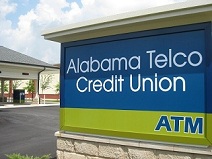
Alabama Telco expanded its business services in early 2012to include loans and the one service that brought Glenn Sasser backto the credit union: international wire transfers.
|Full Business Services
|By February 2012, Telco had a full suite of business servicesthat now included international wire transfers. Thomason said bythe end of 2012, the credit union will have 28 business loanstotaling $5 million in its lending portfolio and $4 million inbusiness deposits. Telco outsources its underwriting with MemberBusiness Solutions LLC, a Tallahassee, Fla.-business lending CUSOwholly owned by the $5 billion Corporate One Federal Credit Unionin Columbus, Ohio.
|Sasser's silkscreen business fell right in with Telco's targetbusiness audience–small to medium-sized with annual revenue of $5million or less. The fledgling manufacturer currently employs twoindependent contractors. While Telco and Sasser have committed togrowing the business, the country's financial downturn has actuallybrought in more clients.
|That's mainly because when the economy is booming, businessesdon't mind spending money on more expensive techniques such asembroidery. But when watching the bottom line became more urgentover the past few years, firms were looking for ways to stretchdollars and do more with less. Some turned to remeshing as analternative.
|“His business is a perfect example of a small business that isexpanding,” Thomason said. “His product was so unique because notmany people were doing it, but there is a need for it.”
|Thomason said after looking at Sasser's business plan,financials and his expanding customer base, Telco saw anopportunity to support a homegrown firm. The credit union approveda line of credit for Sasser to buy a new bar stretcher, a machinethat pulls mesh in four directions and allows it to be glued to aframe.
|“When we started out business loan program, we cherry picked ourloans because we wanted to do it the right way,” Thomason said. “Alot of banks were not lending even though there were greatbusinesses out there with strong cash flow and strong sales. Theyjust didn't fit the banks' model. Those were the ones we wanted totarget.”
|From her days as a former banker, Thomason said she noticed thatwhile businesses had substantial cash flow over the last 10 to 15years, banks were only looking at one year of the financials. If abusiness had a poor credit score or was too small, some financialinstitutions stopped offering them products such as lines of creditand loans in an effort to clean up their books, she added.
|“We look at trends and the whole picture. We know thatbusinesses may have down time,” Thomason said. “I never like to sayno to a member, but I have to be cautious because the decision hasto benefit the credit union and members. I've had to tell people,'This loan is not going to help you.' If they're declined, I'lltell them what they need to work on. We try to find a happymedium.”
||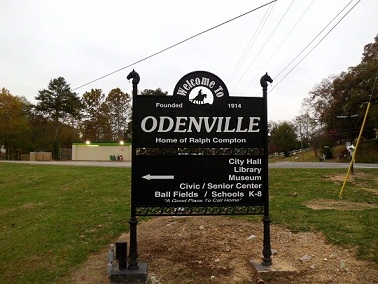
Odenville, a town of 3,585 about 20 miles northeast ofBirmingham, Ala., is home to Glenn Sasser's business, A Plus SilkScreen.
|Equipment Upgrade
|Telco has certainly provided some financial ease for Sasser tocontinuing funding his business. Still, that doesn't stop thetossing and turning on other issues. If it's 2 a.m., he is likelysomewhere struggling to get back to sleep.
|Somewhere might be his warm bed in a modest home off a quietroad in Odenville. Or, as a full-time commercial truck driver, hemay be catching a few winks at a truck stop off any given highwayzigzagging across Georgia, South Carolina or Tennessee en route todeliver a haul.
|Sasser laughed heartily when asked if we could meet early oneSaturday morning, say, around 11 a.m. “That's early?” he teased. “Iusually get up around 3 a.m. I get up, eat my biscuit, and I'm onmy way.”
|His restlessness stems from always thinking about ways to grow APlus Silk Screen, from calculating the potential revenue from a bigmanufacturer on the East Coast to how a new welding machine will beable to put together more frames much faster.
|Born in Florala, Ala., a border town named for its spot on theFlorida and Alabama state line, Sasser got his entrepreneurialstart at 13, shoveling snow and cutting grass for neighbors.Earning part of his keep, the extra funds covered expenses andprofits left over to buy what a teenager might in 1970.
|Back then, Sasser figured an equipment upgrade could surelyboost profits. One summer day, he approached his father, awell-known figure in town, about a possible loan.
|“I asked him for $300 so that I could get a better,self-propelled lawnmower,” Sasser recalled. “We went down toCitizens Bank. It was one of those hometown banks where everyoneknew my dad. Well, I got the loan.”
|And Sasser paid back every cent.
|Because his father was in the Navy, the family relocated aroundthe country, but Sasser landed back in Alabama in 1984. The early1980s were a boon when he worked for an oil drilling company making$100,000 a year. Then the industry's bottom fell out and at the ageof 23, Sasser faced a stark reality. “From that time on, I knew toalways have a backup plan.”
|Along the way he married Sara, who was a member of Alabama TelcoCredit Union and worked for a local firm that made welding fixturesand other pieces of equipment.
|Sasser's brother-in-law owned an excavating company andencouraged him to get a commercial driver's license so that hecould help him make truck runs. Sasser was soon driving up and downthe nation's highways for a major company.
|The next part of Sasser's entrepreneurial circle came in 1989when he started a leather arts and crafts making business. Soonafter, a friend began having health problems and asked Sasser if hewould be interested in taking over his car tag kiosk at a localmall. For $4.50 a piece, he sold splashy car adornments thatfeatured 300 custom designs, including trucks, fishermen, flowersand names in big, bold colors and scripts. “I did really well,” hesaid, cracking a rarely seen smile, remembering the boomingactivity.
|Sasser was now running two businesses while continuing to drivea tractor-trailer to haul goods all over the East Coast.
||Garfield T-Shirt
|The silk screening came on a whim. Sasser's stepdaughter askedif he would design a Garfield T-shirt for Christmas. Puzzled aboutwhether he could pull it off, Sasser thought about the process andhow it compared to the airbrushing he did know how to do on hisleatherwork.
|Pleased with how the T-shirt came out, Sasser wondered how muchmore he could do with silk screens. After doing extensive research,he bought a one-station, four-color printing screen and built astretcher to place the frames and screens on. One day, aninquisitive fellow stopped by and asked what Sasser was planning todo with all of the old frames. That question led to his firstattempts at remeshing.
|At the time, Sasser had been on the road for 10 years when Sarasaid of the leather and car tag businesses, 'We're changingpresidents, the economy's going to change, why don't you just sellthem?'
|Sasser agreed and sold the shops in 2000. Sara's job kept hertraveling nearly three weeks out of the month. Together, the couplemade treks all over Alabama with Sasser drumming up new contactsalong the way for his silkscreen business, still in itsinfancy.
|Everything hummed along. The two were able to spend more timetogether, and Sasser and Sara were “in high cotton,” earning about$180,000 a year between his truck driving, the frame business andher salary. They had dreams of buying a house along the picturesquebeaches of Gulf Shores, Ala., where ocean fishing and lush golfcourses were common lures to the coastal community.
|The day Sara died on Dec. 23, 2007, Sasser's plans didn't matteranymore as he re-lived the image of his wife dying in his arms.
|“It was a video. I couldn't stop seeing it. It played over andover. I call them daymares. As long as I was awake, it was there,”Sasser recalled. “That lasted for about two years. I can talk aboutit now, but before, if someone said something like '23rd,' I'dflash back.”
|After deciding to continue on, a pivotal turn actually came whena company Sasser did remeshing for decided to get out of theoutsourcing business. He started buying wooden frame blanks from afirm in Michigan, remeshed them and sold them to a company locatednear where he lived. For years, the relationship was a veryprofitable one even though it took him out of circuit with endusers or those who just wanted to print items such as T-shirts.
|When the company that pulled the plug on its remesh outsourcingwith Sasser, it closed up a substantial stream of income. Sassersaid he was making $50,000 on the weekends. Still, he was confidentthat he had tapped into something with potentially bigger incomestreams.
|He started purchasing equipment with some of his savings,including a clamp stretcher for $23,000 and then a motor-drivenclamp stretcher, which dwarfs the bar stretchers and cost around$80,000. In all, he has four clamp stretchers.
|“I've got Cadillacs now,” Sasser said of his upgraded equipment.“With the amount of work we're getting, they have literally paidfor themselves.”
|In the beginning, Sasser was conducting his business from a 14-by 32-foot shed behind his home. He quickly outgrew the space andwas able to secure financing from Telco for a 1,200-square-footbuilding and units to cool and heat the shop. Together, thebuilding and wiring cost $27,000, which he could afford thanks tohis Telco line of credit.
| 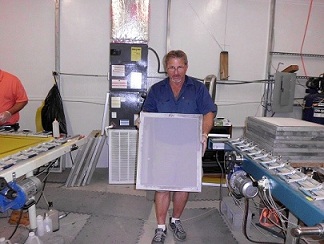
As A Plus Silk Screen grew, Glenn Sasser not only need morefunds but more employees. Two years ago, Eddie Lawson, picturedhere, came aboard as an independent contractor.
|Needing Extra Funds
|Thomason recalled that just as Sasser was nearing the completionof the new building, he needed additional cash. After somerestructuring, she was able to free up some extra funds. Evenconsidering how fast his business is growing, Sasser's not worriedabout running out of space. He said he has enough acreage to putthree more similar-sized buildings on his property.
|“Without the credit union, I wouldn't be where I am.”
|Sasser still uses the smaller building behind his home to comeup with faster and more precise equipment to weld the aluminumframes together. A machine called a Gopher binds corners togetherin four seconds.
|Stepping inside, long, thin planks of aluminum are stackedknee-high in the middle of the space. On the wall opposite theGopher is a machine with three drills that cuts the piecesimmaculately. In the corner is a creation that has the promise ofwelding frames much faster than some of its competitors.
|A fellow trucker, Eddie Lawson, built the automated spot welder.He has been working with Sasser on the silkscreen business for thelast two years. Tanned with light, copper colored hair, Lawsonencouraged this reporter to weld a frame on the Gopher. With all ofits knobs and gadgetry and the fear of possibly cutting a fingerhanging in the air, the weld was surprisingly light, fast and easy.Lawson filed the edges down super smooth to prevent any cuts.
|He is almost giddy over the potential speed of the machine inproducing more frames.
|“I've seen so much over the past two years. Putting in the extrahours is worth it,” Lawson said.
|It helps, he added, working with some that abhors sugarcoating.
|“He doesn't pull punches. To my knowledge, he's never lied tome,” Lawson said. “He's been in it so long. He has the businessknowledge, that's for sure.”
|Roughly a year ago, Eddie's son, Douglas, 22, came on board totrain under Sasser. The younger Lawson now moves deftly betweenstretchers using a Newton meter to measure the tautness of the meshpulled over the frames.
|At the time of the visit, Douglas' fiancée was due any day withtheir first child. Still, he continued to work well into theevening, checking in with Sasser on the next tasks that awaitedhim. On Nov.1, the couple welcomed their daughter into theworld.
|Adding Employees
|Sasser said he envisions the day when the Lawsons will berunning the business without him. Ideally, he would like to have 10to 15 employees.
|And, he's still thinking about heading down to Gulf Shores.Telco provided the financing for a piece of property there butbecause the insurance was higher than the mortgage payment, heopted out of it.
|Sasser is also dating again. About three and half years ago hebecame reacquainted with Charayne Yancey. They lived about fivehouses down from each other growing up in Alabama. Though youngerthan Sasser, Yancey chuckled at her failure to remember the kid whowould cut her parent's grass while she practiced her majorettemoves in the front yard. They later went to the same high schooldances but still never really interacted despite Yancey's cousinand Sasser being best friends.
|“He said, 'I'll never forget how you looked in that shiny, bluemajorette suit,'” said Yancey, who grew up in Opp, an Alabama town20 miles from the Florida state line.
|Sasser left the area at the age of 18. Both went on with theirlives, got married and settled down. Ironically, Yancey became acommercial truck driver too, making runs from coast to coast. Itwas in 2009 when their paths crossed on Facebook. Yancey's husbandhad died, so she knew the type of grief Sasser experienced when hiswife died in 2007.
|“I think he needed someone to talk to,” Yancey recalled. “Wefound out we had a lot in common.”
|Soon, Yancey became one of Sasser's biggest cheerleaders,encouraging him to keep going with his business. She works in salesand takes advantage of any opportunity to talk up A Plus SilkScreen. A few clients have come his way through her word ofmouth.
|But the couple has a long-distance relationship. She lives 200miles away from Sasser. An only child, Yancey still lives in Opp sothat she can care for her elderly mother. While they only see eachother once a month, it's clear that when they lock eyes, there is atrue connection.
|“His bark is a lot worse than his bite. He's sweet,” Yanceysaid. “You know, we sometimes agree to disagree on things.”
|On a recent gray, autumn evening over a meal of juicy hamburgerswith thick slices of tomatoes, red onions, crisp green lettuce andbottles of Coca-Cola, Sasser thought about where he wants to takehis business and whether the work has taken a toll on him.
|“Being an entrepreneur is a blessing and a curse. A blessingbecause it's what drives me. Without it, I would've given up a longtime ago. A curse because my mind never gets to shut down.”
|Yancey nodded in agreement on the curse explanation. A petitewoman with beautifully manicured pink nails and feathered brownhair, she has a soft spot for the cats that roam in and out ofSasser's house.
|“I think it's rubbed off on me. Numbers are always going throughmy head,” she said.
|On our way back to the shop, Sasser pointed to Eddie and said,“I think I've rubbed off on him, too, because he thinks about thebusiness just as much as I do.”
|Charayne Yancey grew up five houses down from Glenn Sasserin rural Alabama. Since reconnecting on Facebook, she's been one ofhis biggest cheerleaders, bringing in a few new clients to Sasser'sgrowing business.
|Even though a $100,000 loan from Wells Fargo may have helpedtowards the purchase of more materials to make frames, Glenn Sasserrefused to do business with any bank.
|Banks Beg
|So committed are they to taking the silk screen and frame-makingoperation to the next level, Sasser and the Lawsons have workedthrough the night to fill orders. A buyer from Las Vegas recentlyflew in to pick up 100 frames, their largest order to date.
|Things are moving so fast that more banks and other entitieshave started contacting Sasser to inquire about establishingpartnerships. Wells Fargo Bank recently offered him a $100,000loan, but he turned it down.
|“I didn't want to go back to the big banks,” Sasser said.
|Between Telco and the $140,000 of his own money that he'sinvested in the business, Sasser said it's hard to say when he willbe able to stop making truck runs. He's ready though.
|“I'm doing more business now than I was 10 years ago. I havegrown since the downturn.”
|Sasser said small businesses have a litany of taxes to dealwith. Yet, he's not bitter about it.
|“When it's all said and done, taxes are coming whether you likeit or not. I've been in a recession before. I remember when youcouldn't sell gas on Sundays,” Sasser said. “The economy isresetting itself.”
|With only six major frame companies in the United States, A PlusSilk Screen could be the final arc in the entrepreneurial circlethat began to form when Sasser shoveled snow and cut grass as ayoung boy.
|And it's not going to happen by aligning with banks. “All ofthat is greed, and it will get you every time,” Sasser said of thebanking industry's ongoing attempts in Washington to limit businesslending authority for credit unions.
|With Telco backing him, continued growth is not a dream–it's arequirement. He reflects on where he would be if his wife hadlived.
|“Neither one of us made enough money separately to support thewhole household. When you have just one income, you have to watchthings more carefully. I see this as my second chance. I got onelist with 1,300 customers on it. They're not my customers–yet.”
|Complete your profile to continue reading and get FREE access to CUTimes.com, part of your ALM digital membership.
Your access to unlimited CUTimes.com content isn’t changing.
Once you are an ALM digital member, you’ll receive:
- Critical CUTimes.com information including comprehensive product and service provider listings via the Marketplace Directory, CU Careers, resources from industry leaders, webcasts, and breaking news, analysis and more with our informative Newsletters.
- Exclusive discounts on ALM and CU Times events.
- Access to other award-winning ALM websites including Law.com and GlobeSt.com.
Already have an account? Sign In
© 2024 ALM Global, LLC, All Rights Reserved. Request academic re-use from www.copyright.com. All other uses, submit a request to [email protected]. For more information visit Asset & Logo Licensing.


